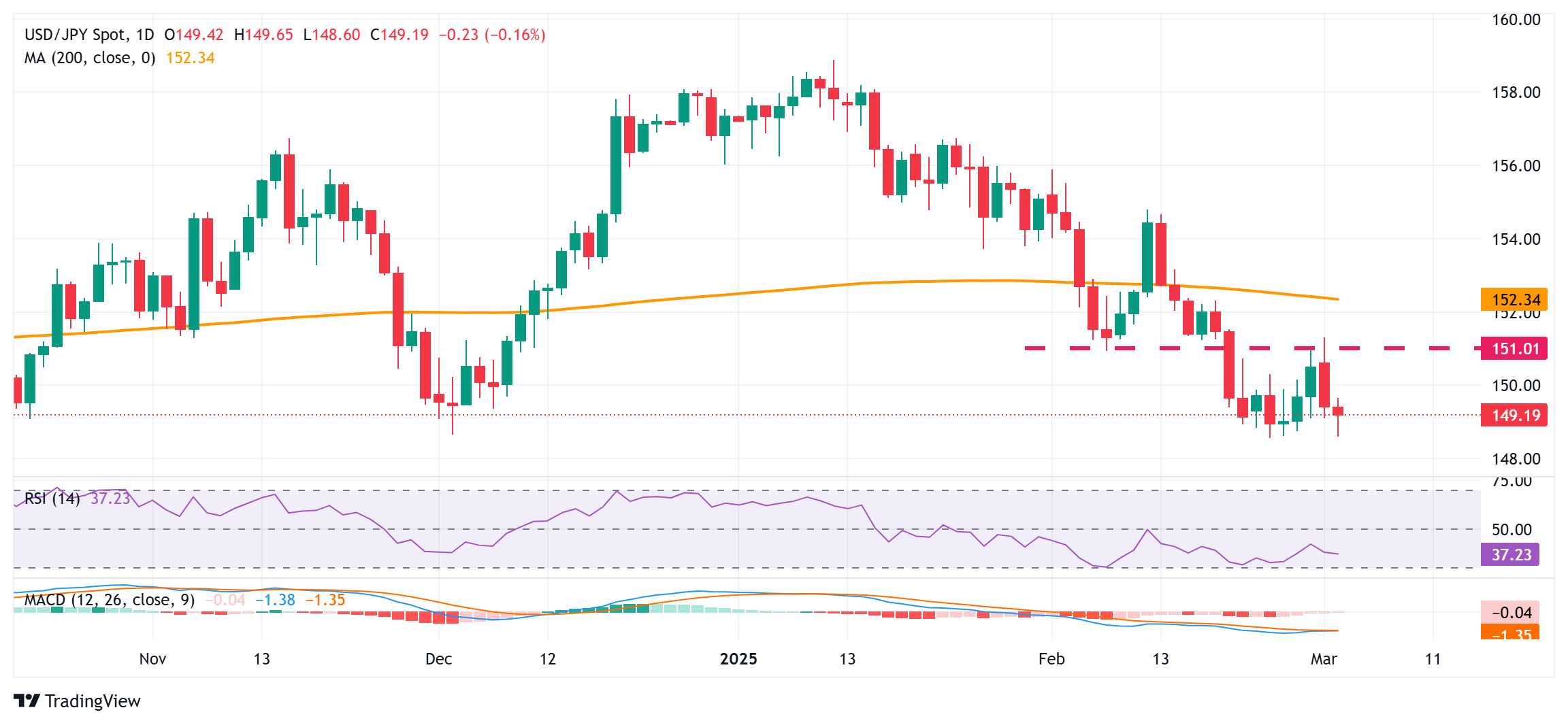The Japanese yen again approached multi-month highs against the US dollar on Tuesday.
Expectations of Bank of Japan rate hikes and risk aversion provided good support for the safe haven yen.
Expectations of further rate cuts by the Federal Reserve weakened the US dollar and further pressured USD/JPY.
The Japanese yen (JPY) attracted follow-through buying for a second day on Tuesday, returning to near multi-month highs reached against its US counterpart last week. Hawkish sentiment surrounding the Bank of Japan (BoJ) policy outlook continued to support the yen. Moreover, concerns about the possible economic impact of US President Donald Trump's tariff policy curbed investor demand for risky assets, further benefiting the safe haven yen.
Moreover, Trump's currency devaluation threats against Japan, as well as weak US dollar (USD) price action, became other factors exerting downward pressure on USD/JPY. Meanwhile, yen bulls seemed unfazed by weak macro data from Japan, which unexpectedly showed rising unemployment and a decline in corporate capital expenditure for the first time in three years. This, in turn, suggests that the resistance path for the yen remains to the upside.
Growing speculation that the Bank of Japan will raise interest rates sooner has pushed the benchmark 10-year Japanese government bond yield close to its highest level since 2009 and continues to support the Japanese yen.
Ukrainian President Volodymyr Zelensky's meeting with U.S. President Donald Trump ended in disaster on Friday.
Adding to market uncertainty, White House officials confirmed that the U.S. has suspended military aid to Ukraine.
Trump's tariffs on Mexican and Canadian goods will take effect on Tuesday, along with new 10% tariffs on Chinese goods.
China's Ministry of Commerce vowed to take necessary countermeasures to safeguard legitimate rights and interests.
Trump said on Monday that he had warned Chinese and Japanese leaders not to devalue their currencies against the dollar, arguing that such actions put American industry at a disadvantage.
Japanese Finance Minister Katsunobu Kato said on Tuesday that the country is not pursuing a policy of devaluing its currency and has confirmed its "basic monetary policy stance" with U.S. Treasury Secretary Scott Bessant.
In a separate press conference, Japanese Economy Minister Yoshio Akazawa said the government would intervene in the foreign exchange market only when market movements are "speculative."
Data released earlier on Tuesday showed that Japan's unemployment rate unexpectedly rose in January, from 2.4% to 2.5%, while Japanese companies reduced equipment and plant spending by 0.2% in the October-December period.
The Institute for Supply Management (ISM) Manufacturing Purchasing Managers Index slipped to 50.3 from 50.9 in February, while the Prices Paid Index jumped to 62.4, close to a three-year high, on concerns about import tariffs.
Moreover, investors remain concerned that Trump's policies will increase price pressures and slow activity in important industrial sectors. This could force the Fed to cut rates further and put pressure on the dollar.

From a technical perspective, overnight failure near 151.00 support, now turned into resistance, validates the short-term bearish outlook for USD/JPY. Moreover, the oscillators on the daily chart are deeply in the negative zone and are still far from entering the oversold zone. This in turn supports the continuation of the ongoing downtrend that the pair has seen in the past two months or so. Therefore, a break below the mid-148.00s makes a slide towards the next relevant support around the 148.00 round number mark a distinct possibility. The downward trajectory could extend further to the 147.35-147.30 area, passing through the 147.00 mark.
On the other hand, the 149.65-149.70 area now appears to be an immediate obstacle before the 150.00 psychological mark. Any further gains may still be seen as a selling opportunity around the 150.60 area, which in turn should limit the gains of USD/JPY around the 150.90-151.00 key barrier. The latter should serve as a pivot point that, if decisively breached, could prompt a short-term covering rally towards the 151.40-151.45 intermediate barrier, passing through the 152.00 round number and the 152.35 area, or the all-important 200-day Simple Moving Average (SMA).
The Japanese yen (JPY) is one of the most traded currencies in the world. The value of the yen is largely determined by the performance of the Japanese economy, but more specifically by factors such as the Bank of Japan’s (BoJ) policy, the difference between Japanese and US bond yields, or risk sentiment among traders.
"One of the BoJ's mandates is monetary control, so its actions are critical to the yen. The BoJ sometimes intervenes directly in foreign exchange markets, usually to weaken the value of the yen, although it does not usually do so due to political concerns among major trading partners. The BoJ's ultra-loose monetary policy between 2013 and 2024 led to a depreciation of the yen against major currencies as policy divergences between the BoJ and other major central banks grew. More recently, the gradual withdrawal of this ultra-loose policy has provided some support to the yen."
Over the past decade, the BoJ has maintained its ultra-loose monetary policy stance, leading to a widening policy divergence with other central banks, especially the Federal Reserve. This has supported a widening spread between the 10-year US Treasury bond and the 10-year Japanese government bond, which has benefited USD/JPY. The Bank of Japan's decision to gradually move away from its ultra-easy policy in 2024, coupled with rate cuts by other major central banks, is narrowing that gap.
The yen is often viewed as a safe-haven investment. This means that during times of market stress, investors are more likely to put money into the yen because of its perceived reliability and stability. Turbulent times can cause the yen to appreciate against other currencies that are viewed as riskier investments.